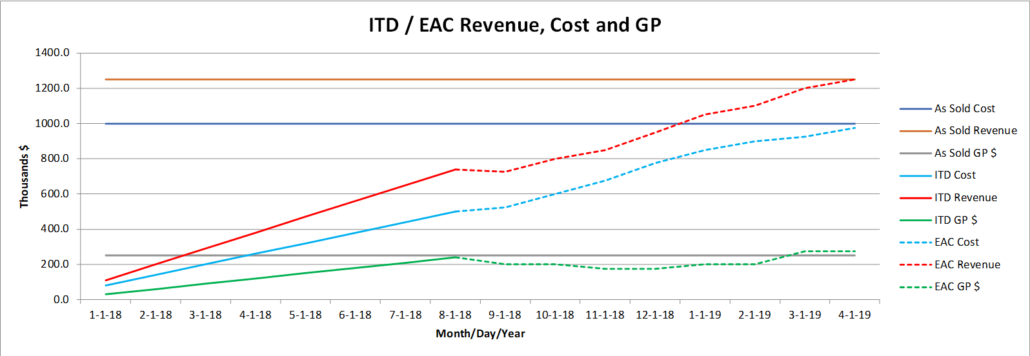Every now and then you come across tool or a process that provides a ton of value in a simple and effective package. This tool or process is easy to understand, easy to integrate into your existing systems, and it provides an extraordinary level of value to you and your business.

The EAC – ITD chart is one of these tools. You need to leverage this tool into your business! Download it from the Business Tools tab on my website.
The Tool
I originally built this tool as a method to track project health when I was responsible for overseeing a large portfolio of projects. It is a simple little graph that tells you right away if your project managers really understand their projects and if their projects are going to meet the organization’s financial expectations.
So, what is it and how does it work?
The EAC – ITD chart is an Excel based graph that you can either export data into or you can build into a larger business system. It consists of only nine parameters, of which only six are actively measured and updated.
The nine parameters are shown in the following screenshot and defined below from a project management perspective:
- As Sold Cost – this is the total cost as per contract including additional CNs, etc.
- As Sold Revenue – this is the total revenue agreed to with the customer on all signed contracts, POs and CNs.
- As Sold GP $ – this is the difference between the As Sold Revenue and the As Sold Cost
- ITD Cost – this is the cumulative cost incurred to date on the project
- ITD Revenue – this is the cumulative revenue recognized to date on the project
- ITD GP $ – this is the cumulative GP realized to date on the project (the difference between ITD Revenue and ITD Cost)
- EAC Cost – this is the projected estimate of the remaining cumulative cost burn rate on the job.
- EAC Revenue – this is the projected estimate of the remaining cumulative revenue recognition on the job.
- EAC GP $ – this is the projected estimate of the cumulative GP remaining to be recognized (the difference between EAC Revenue and EAC Cost)
Application to Business
In addition to project oversight, I have also been able to effectively leverage this tool into business applications with great results!
For example, I was consulting with a start up business run by college students. They were starting and running a business over a 6-month period. They had well defined revenue and profit targets for this 6-month time. We set the EAC – ITD graph up for them as follows:
- As Sold Cost – this is the total business expense they thought they would incur in the 6-month period
- As Sold Revenue – this is the total revenue they thought they would invoice for in 6 months
- As Sold GP $ – this is their projected business profitability (Revenue – Cost)
- ITD Cost – this is the cumulative real cost incurred by the business
- ITD Revenue – this is the cumulative revenue earned by the business
- ITD GP $ – this is the cumulative profit realized by the business (the difference between ITD Revenue and ITD Cost)
- EAC Cost – this is the projected estimate of the cumulative cost for the business. It was originally estimated by dividing the total expected cost over the 6- month period by the number of weeks the business was operating.
- EAC Revenue – this is the projected estimate of the cumulative revenue realized for the business. It was originally estimated by dividing the total expected Revenue over the 6-month period by the number of weeks the business was operating
- EAC GP $ – this is the projected estimate of the cumulative profit for the business over the 6-month period.
What this allowed the students to see immediately was:
- The sales per week required to hit their end of period sales targets
- Their expense burn rate at the end of each week
- Their cumulative profits at the end of each week
These trends were close to real time and provided a powerful motivator for making sales and reducing unnecessary costs. The students were concerned for a while that they would not hit their sales goal but when the graph showed them that their margins were higher than expected, they were able to reduce their revenue targets and focus more on operational efficiency. At the end of their 6 months they were able to exceed their profitability goal!
Take Action
Set aside some time this week to review the tools and processes that your business uses. Do you have what you need to make effective and timely decisions? What gaps do you have and how can you fill them?
Powerful business tools do not have to cost millions of dollars to purchase and implement. Download the EAC – ITD tool and get started today!
Finally, review these related posts for more ideas on powerful business tools:
- How to Build a Powerful Performance Review System That Works
- How to Focus Your Business and Make More Money
- How to Deal with Monumental Change
- How to Become a Focused and Effective Business Leader
- How to Save $30,000 a Month Using OneNote
- How to Leverage Starbucks’ Strategy for Breakthrough Growth
- How to Get Employees to Crush Your Business Goals
“Simplicity is the ultimate sophistication.” Leonardo da Vinci
What simple and powerful tools make a difference in your business? Leave your comments below!
We help leaders navigate marketplace complexities and build successful and lasting business legacies.
Call or email us today for more information or to book your free business assessment:
587-227-5179
info@thinkingbusinessblog.com
Be sure to download a free copy of my new Ebook: 12 Steps to Business Transformation and to sign up at www.thinkingbusinessblog.com for weekly blog updates delivered to your inbox.


Please note: I reserve the right to delete comments that are offensive or off-topic.